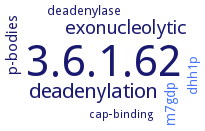3.6.1.62: 5'-(N7-methylguanosine 5'-triphospho)-[mRNA] hydrolase
This is an abbreviated version!
For detailed information about 5'-(N7-methylguanosine 5'-triphospho)-[mRNA] hydrolase, go to the full flat file.

Reaction
Synonyms
D10 decapping enzyme, D10 protein, D9 protein, Dcp1p, Dcp2, Dcp2p, decapping nudix hydrolase, EC 3.6.1.30, H29K, hDcp2, hNUDT16, mRNA decapping enzyme, mRNA decapping enzyme D10, mRNA decapping enzyme D9, Nudt16, Nudt17, Nudt19, Nudt20, NUDT3, U8 snoRNA binding protein, X29, X29 protein
ECTree
Advanced search results
Crystallization
Crystallization on EC 3.6.1.62 - 5'-(N7-methylguanosine 5'-triphospho)-[mRNA] hydrolase
Please wait a moment until all data is loaded. This message will disappear when all data is loaded.
apo-form and in complex with IMP and Mg2+, sitting drop vapor diffusion method, using 0.1 MChes pH 9.5 and 20% (w/v) PEG8000
structures of wild-type, and E198Q and E153Q catalytic glutamate mutants of the Dcp2 Nudix domain, to 2.1A, 1.8 A and 1.7 A resolution, respectively. Conserved glutamate residues E152, E153, and E198 coordinate a magnesium ion through a water mediated contact, while E149 directly contacts the metal. A conserved metal binding loop on the catalytic domain undergoes conformational changes during the catalytic cycle
structure of the yeast enhancer of mRNA-decapping protein Edc3 LSm domain in complex with a short helical leucine-rich motif from subunit Dcp2. The motif interacts with the monomeric Edc3 LSm domain and recognizes a noncanonical binding surface. Additional helical leucine-rich motifs in the disordered C-terminal extension of Dcp2 can interact with Edc3. Both Edc3 and Scd6 stimulate decapping in vitro, presumably by preventing the Dcp1:Dcp2 complex from adopting an inactive conformation. The C-terminal helical leucine-rich motifs in Dcp2 are necessary for the localization of the Dcp1:Dcp2 decapping complex to P-bodies in vivo
crystallizes as a homodimeric apoenzyme. Structure of X29 complexes with m7GpppA and pppG in the presence of Mn+2


 results (
results ( results (
results ( top
top





